The day started well, with clear sunny conditions. It had been a cold night, with the temperature on the mountain dropping well below zero. But by the time I set off from the Mangatepopo carpark at around 10am the air temperature was about 5 degrees, and there were clear sunny skies.
I jogged off up the track, although this was hard work with the gradual climb and the weight of water. Stopping for a few photos and walking the rougher climbs around the end of lava flows, I made the 4.5km to the base of Devil's Staircase in about 45 minutes. I elected to take the old Devil's Staircase rather than the new track with its wooden steps. I could rationalise this as choosing the safer option, as any ice on the wooden steps would be treacherous. In reality, though, I just preferred the path less travelled.
I unclipped my walking poles and then proceeded across South Crater while adjusting them. I was walking along the well-travelled path so the ice and snow had been broken up and was easy walking. A few moments inattention while I was adjusting my poles and I strayed onto the ice, slipped, and came crashing down onto my backside. That certainly gave me a pause for thought, and I wondered whether the climb on the track up the crater wall would even be possible.
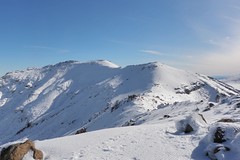
The crater rim, leading to the summit left of centre.
The obvious climb up the ridge to the right of centre
should have been the turn around point. The poled
route traverses diagonally across the shaded snow
slope to the left of that ridge.
The obvious climb up the ridge to the right of centre
should have been the turn around point. The poled
route traverses diagonally across the shaded snow
slope to the left of that ridge.
I assumed that the snow conditions would be better on the other side of the mountain, with more sun having been on the snow during the day, so it *should* have melted more and have less of a hard crust.
Off that slope and it was a relatively easy walk around to the two summits. Another short slope, but the snow on there was ok. Stopped at the main summit for some photos, then started down.
The first couple of metres down were fine, but then it all quickly turned bad. Relatively soft snow turned icy and I had to carefully lever myself down holding on to some rocks. A few more steps on good snow, then I slipped on an icy patch and fell. On the icy patches it seemed easier and safer to stay seated, kick my heels into the surface and then inch forward. Reaching a better patch of snow I would stand up and try walking again, only for the same thing to happen again. I inched every so slowly down, taking almost 2 hours to travel 850m.
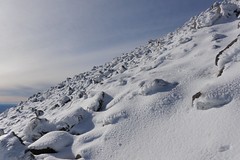 The slope down. It was a lot icier than this in many places, but I wasn't so keen to stop and take a photo in those spots!
|
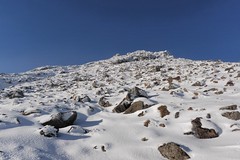 Looking back at where I had come down.
|
The day after my trip there was a news story of a tramper who fell in icy conditions on Mt Egmont, fracturing his lower leg. That scenario certainly crossed my mind several times as I inched my way down from the summit. The slope is not extreme, but the icy conditions were treacherous. Relatively soft snow would suddenly give way to ice, and on at least four occasions I slipped and fell down. It would have been all too easy to accelerate away down the slope only to come to a crashing halt against the rocks. Luckily in all instances the ice gave way to softer snow and I could dig my heels in before sliding too far.
Having dropped low enough the slope eased up a little and the snow became a lot softer, with some patches of powder. I could now stand up and walk at a good pace. I was fed up with this now and wanted to get back to the car. Another half an hour and 1.3km and I was back down at the Mangatepopo Valley track. I jogged most of the way back to the car, stopping again at the most technical sections, and also stopping to talk to an older couple who had been up to South Crater for the day. Less than 1km from the car my tiredness made itself known as I tripped on a rock and fell, crashing my right hip into another rock. A large purple bruise and some abrasions, but nothing serious.
Risk Assessment
This was a "near miss". I got off the mountain in one piece, but with no safety margin. I slipped and fell four or five times while standing, and also slid a couple of times while sitting. Any one of those slips could have resulted in an uncontrolled slide and a fracture like what was suffered by the tramper on Mt Egmont.
The pre-trip risk assessment should have considered the need for an ice axe and/or crampons. With those the entire loop could have been completed safely.
While on the mountain I should have questioned my assumption about better snow conditions on my intended route down. I should have explicitly considered the possibility that the conditions might be as bad, or worse than the route up, and then made a decision accordingly.
More photos available on Flickr.
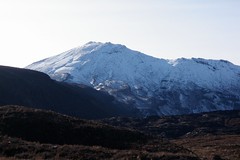
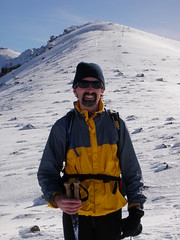
1 comments:
Hi Andrew. Thanks for the read. I think too few people are comfortable writing about near-misses, or occasions when they might have made bad decisions, so there's possibly a perception out there that it happens far less frequently than it does. It's good to see them pop up from time to time.
Post a Comment